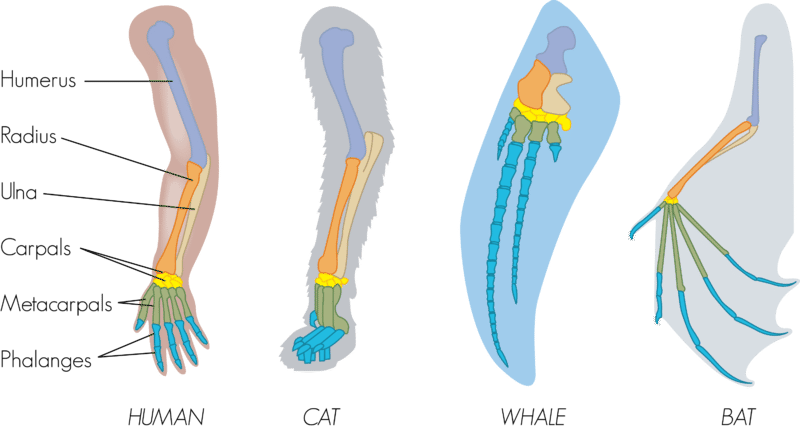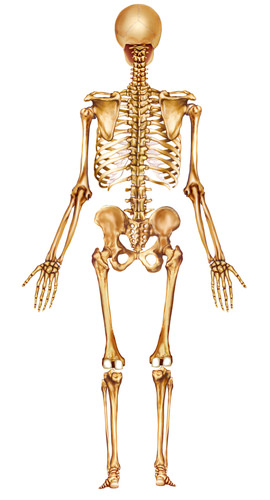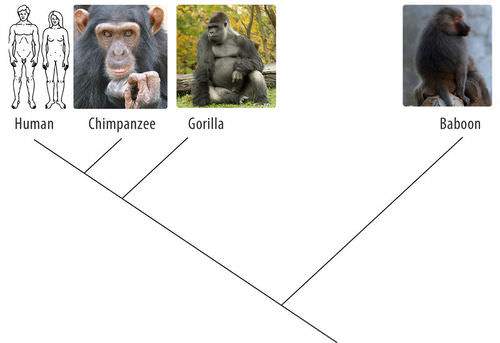READ: Comparative Anatomy and DNA
READ: Comparative Anatomy and DNA
Is this evidence of evolution? Take a close look at this gorilla hand. The similarities to a human hand are remarkable. Comparing anatomy, and characterizing the similarities and differences, provides evidence of evolution. Just as Darwin did many years ago, today’s scientists study living species to learn about evolution. They compare the anatomy, embryos, and DNA of modern organisms to understand how they evolved.
Comparative Anatomy
Comparative anatomy is the study of the similarities and differences in the structures of different species. Similar body parts may be homologies or analogies. Both provide evidence for evolution.
Homologous structures are structures that are similar in related organisms because they were inherited from a common ancestor. These structures may or may not have the same function in the descendants. The figure below shows the hands of several different mammals. They all have the same basic pattern of bones. They inherited this pattern from a common ancestor. However, their forelimbs now have different functions.
The forelimbs of all mammals have the same basic bone structure.
Wings of bats and birds serve the same function. Look closely at the bones inside the wings. The differences show they developed from different ancestors.
Structural Evidence
Why do you have a tail bone?
If you look closely at a skeleton, you might notice a triangular bone at the end of the spinal column. This is your tailbone. Why would you have a tailbone when you don't have a tail? You have a tailbone because your ancient ancestors did have a tail. These sorts of "left-over" structures support the theory of evolution.
Even though two different species may not look similar, they may have similar internal structures that suggest they have a common ancestor. That means both evolved from the same ancestor organism a long time ago. Common ancestry can also be determined by looking at the structure of the organism as it first develops.
Vestigial Structures
Some of the most interesting kinds of evidence for evolution are body parts that have lost their use through evolution. For example, most birds need their wings to fly. But the wings of an ostrich have lost their original use. Structures that have lost their use through evolution are called vestigial structures. They provide evidence for evolution because they suggest that an organism changed from using the structure to not using the structure, or using it for a different purpose.
Penguins do not use their wings, known as flippers, to fly in the air. However, they do use them to move in the water. The theory of evolution suggests that penguins evolved to use their wings for a different purpose. A whale’s pelvic bones, which were once attached to legs, are also vestigial structures. Whales are descended from land-dwelling ancestors that had legs.
The human appendix is another example of a vestigial structure. It is a tiny remnant of a once-larger organ. In a distant ancestor, it was needed to digest food. It serves no purpose in humans today. Why do you think structures that are no longer used shrink in size? Why might a full-sized, unused structure reduce an organism’s fitness?
Comparing DNA
Darwin could compare only the anatomy and embryos of living things. Today, scientists can compare their DNA. Similar DNA sequences are the strongest evidence for evolution from a common ancestor. More similarities in the DNA sequence is evidence for a closer evolutionary relationship. Look at the cladogram in the figure below. It shows how humans and apes are related based on their DNA sequences.
Cladogram of Humans and Apes. This cladogram is based on DNA comparisons. It shows how humans are related to apes by descent from common ancestors.
Summary
- Scientists compare the anatomy, embryos, and DNA of living things to understand how they evolved.
- Evidence for evolution is provided by homologous structures. These are structures shared by related organisms that were inherited from a common ancestor.
- Other evidence for evolution is provided by analogous structures. These are structures that unrelated organisms share because they evolved to do the same job.
- Vestigial structures, or structures that have lost their use through evolution, are important evidence of evolution.
- Comparing DNA sequences provided some of the strongest evidence of evolutionary relationships.




